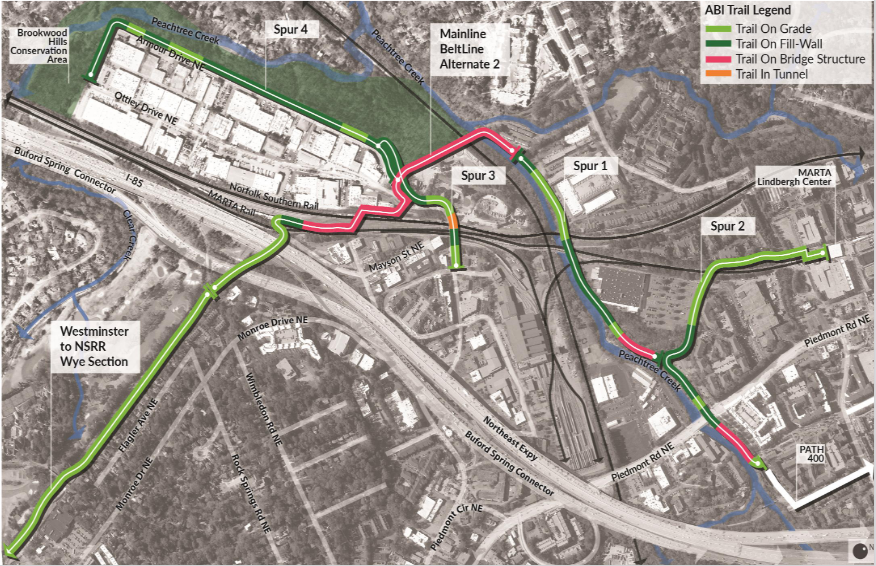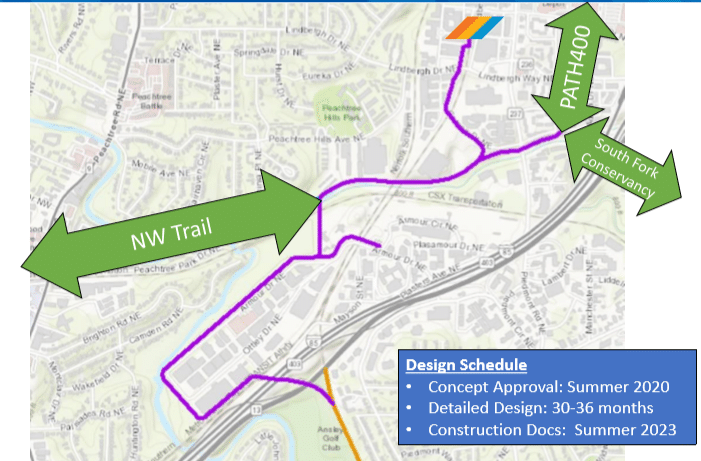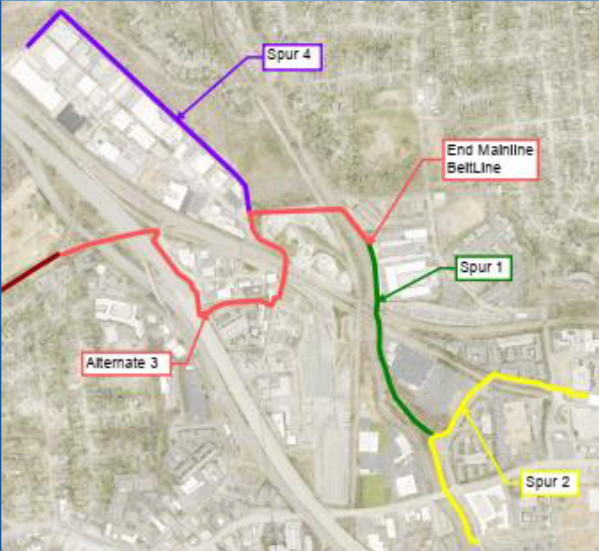Railroad company Norfolk Southern’s objections have killed the Atlanta BeltLine Northeast Trail’s proposed route into southern Buckhead. A new alternative route, which is still under review, would have a tight spot forcing the light-rail transit part of the BeltLine to run on one track instead of two.
The change also means that the Armour/Ottley commercial district, rather than being on the main BeltLine, would be on a spur trail that is a longer construction timeline.

Atlanta BeltLine Inc., the organization building the 22-mile park, trail and transit loop around the city, unveiled the proposed new route at a July 15 virtual meeting. The proposal itself is still under review and would be at least three years away from a construction start.
“We’ve tried everything within our bag of tricks… and there’s just not a way to do it,” ABI engineer Shaun Green said of the attempt to salvage the original proposed route, which was sidetracked by objections from railroad operator Norfolk Southern Corporation.
The Northeast Trail segment would connect the existing Eastside Trail from Monroe Drive and 10th Street in Midtown to Buckhead’s Lindbergh Center MARTA Station. A short section along the Ansley Golf Club is already open in a semi-finished state and other sections are in a rudimentary gravel-covered state.
The most complex part of the route is in Buckhead between the Armour and MARTA station areas, as it has to navigate a labyrinth consisting of commercial, industrial and residential uses; highway bridges and ramps; Peachtree Creek; and MARTA and Norfolk Southern rail lines.
ABI worked on alternative routes for 18 months before announcing a preferred version in May 2020. But behind the scenes, Norfolk Southern was voicing concerns, which came as a surprise to the public in a December 2020 meeting. The railroad company is scheduled to open its new corporate headquarters in Midtown later this year.
Green said that ABI’s attempts to satisfy the railroad’s concerns about right of way and other impacts failed and only got worse. He said that “we were unable to address all the comments and concerns that Norfolk Southern had, and then we ended up creating additional problems.” He said mitigations might have cost an additional $50 million — an over 45% increase of current funding — and still had no way to accommodate the BeltLine’s own transit.

The former route plan was based on the idea of using an existing, Y-shaped pair of railroad bridges and tunnels to cross I-85. The trail would go on the southern branch of the Y and the transit would run on the northern branch.
A new route proposal puts both the trail and the transit on the northern branch, with the trail then running to the area of the Atlanta Decorative Arts Center on Peachtree Hills Avenue. Four spur trails would connect from there to the Armour/Ottley, Lindbergh Center and PATH400/Adina Drive areas. In that Peachtree Hills Avenue area, the Northeast Trail eventually would connect with another BeltLine segment, the Northwest Trail, which just started its preliminary planning.
ABI considered two alternatives for the new Northeast Trail route. One tunnels under the Norfolk Southern and MARTA tracks and winds through surface streets. Green said that alternative has not been ruled out, but is disliked because of many conflicts between pedestrians and traffic, as well as potential rail impacts that would be expensive to solve.

The other — and ABI-preferred — alternative puts much of the main BeltLine trail on a bridge over the tracks and Peachtree Creek.
Green said an advantage of the new route is that it’s shorter and more direct in connecting Midtown and Lindbergh, “which we feel is pretty powerful.”
The big disadvantage is that there is not room for a two-way BeltLine transit line on the Y-shaped bridge. That’s exactly what ABI wanted to avoid with the original proposal of splitting the trail and transit on the two branches of the Y. Green said that MARTA is studying the pinch point and ways to mitigate the single-track situation.
“It’s not the end of the world and it’s not going to be the only point on the BeltLine where existing infrastructure forces a single-track condition,” Green said.
Another issue is money. Green said ABI currently has $109 million to build the trail and believes that will cover the main trail into Buckhead and “Spur 1,” a short branch that would connect to Garson Drive. But ABI currently has no funding for the other three spurs, and is already in the process of seeking it, Green said.
As for the Northeast Trail segment to the south, along Piedmont Park between 10th Street and Westminster Drive, that remains at least two years away from construction, officials said. A fresh covering of gravel on the interim trail there may be on the way sooner.
The current long-term plan is for the trail portion of the BeltLine’s 22-mile loop around the city to be completed by 2030 and the transit portion by around 2050. For more information, see beltline.org. For the full presentation from the July 15 Northeast Trail meeting, click here.
